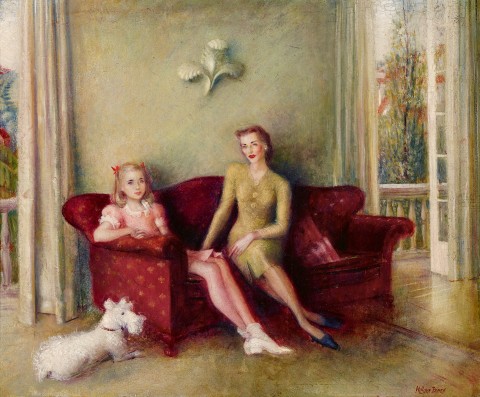HELEN BLAXLAND AND TONIA, 1941
WILLIAM DOBELL
oil on wood panel
44.5 x 53.5 cm
signed lower right: WILLIAM DOBELL
dated and inscribed verso: Mr Gregory Blaxland / 11 Wallaroy Road / Woollahra / Painted / 1941
Commissioned by Gregory and Helen Blaxland, Sydney
Christie’s, Sydney, 3 March 1972, lot 99 (as ‘Conversation Piece’)
Private collection, Sydney
Geoff K. Gray, Sydney, 12 November 1984, lot 45 (as ‘Conversation Piece’)
Mr and Mrs René Rivkin, Sydney
Sotheby’s, Sydney, 3 June, 2001, lot 18 (as ‘Conversation Piece’)
Gould collection, Melbourne
Annual Exhibition, Society of Artists, Education Department’s Gallery, Sydney, 6 – 26 September 1941, cat. 162
Margaret Preston and William Dobell Loan Exhibition, National Art Gallery of New South Wales, Sydney, 19 March – 16 April 1942, cat. 10 (label attached verso)
William Dobell, David Jones Art Gallery, Sydney, 1 – 26 August 1944, cat. 50 (as ‘Mrs. Blaxland and Tonia, 1942’)
William Dobell: Paintings from 1926 – 1964, Art Gallery of New South Wales, Sydney, 15 July – 30 August 1964, cat. 83, (as ‘Mrs Blaxland and Toni’) (label attached verso)
100 Years of Great Australian Art, Gould Galleries, Melbourne, 2 – 28 March 2004, and Gould Galleries, Sydney, 6 April – 9 May 2004, cat. 13 (illus. in exhibition catalogue)
The Director’s Choice 2015, Celebrating 35 Years, Gould Galleries, Melbourne, 1 May – 13 June 2015, cat. 5 (illus. in exhibition catalogue)
Best in Show: Dogs in Australian Art, Orange Regional Gallery, Orange, 9 April – 3 July 2016, cat. 14
Penton, B., The Art of William Dobell, Ure Smith, Sydney, 1946, pp. 8, 122 (illus. as ‘Mrs Blaxland and Toni’)
Gleeson, J., William Dobell, Thames and Hudson, London, 1964, cat. 98, p. 193
Helen Blaxland and Tonia belongs to a small suite of portraits painted by William Dobell in Sydney in the early 1940s, before the crippling traumas inflicted on him by the notorious Archibald Prize court case of 1944. This stylised double portrait shares many of the classic Dobell traits evident in such contemporaneous works as The Tattooed Lady 1941 (private collection), Elaine Haxton 1941 (Art Gallery of New South Wales) and particularly, another society commission Jacqueline Crookston 1940 (private collection), where the ‘poses and groupings have the artificial feel of the studio about them … touched with such breath-taking lightness and with such an exquisite sense of rhythm. Dobell is attracted by the possibilities of this highly finished artificial elegance.’1
The artist had returned to Australia from London in 1939 after attending the Slade School, where he had already developed a unique, penetrative talent for depicting people from all walks of life. On arrival in Sydney, he found himself a two-bedroom apartment above a bank in Kings Cross, with one room used as a living space, the other as a studio.2 Thus settled, Dobell renewed his acquaintance with the influential publisher Sydney Ure Smith who began to actively promote his work; and soon he was painting a range of notable society and Government figures. Donald Friend records dinner parties in his diaries that included Ure Smith, Dobell and ‘Mrs Greg Blaxland’,3 so it seems apparent that the publisher also introduced the artist to this potential sitter. Helen Blaxland and Tonia was one of his first portrait commissions.4
Helen Blaxland (nee Anderson, 1907-1989) was a tall and stylish woman who devoted considerable energy to a wide range of worthy pursuits. She originally studied at the Julian Ashton School of Art and when the Second World War erupted, she worked as a fundraiser with the Australian Red Cross Society. In 1946, she collaborated with the photographer Max Dupain and artist Elaine Haxton on a popular book on flower arranging; and in 1959, Blaxland joined the nascent National Trust. As a result of her important and extended contribution to the conservation group, she was awarded a DBE in 1975. Blaxland was also a foundation trustee of the National Parks and Wildlife Foundation (New South Wales); and in 1978 she became foundation chairman of the Australiana Fund, set up to acquire Australian furnishings for the four official Commonwealth residences.5 Daughter Antonia (known as Tonia or Toni) became a noted photographer following an apprenticeship with Dupain.
The family’s mansion, ‘Brush’, occupied a prominent location in Sydney’s Bellevue Hill. Noted art collectors and patrons, the Blaxlands owned significant pieces by Russell Drysdale, Sidney Nolan, Donald Friend and David Strachan; and the designer Loudon Sainthill was responsible for the decor of the sumptuous lounge room where Blaxland and her daughter are seen sitting. With glimpses of the harbour and lush gardens beyond the curtains, and crested by a Sainthill-designed wall sconce, Dobell presents Helen, Tonia, and Crown, their Sealyham terrier, as very comfortable occupants within their own stylish – and highly stylised – environment.
1. James Gleeson, William Dobell, Thames and Hudson, London, 1964 (1969), p.80.
2. Corner of Darlinghurst Road and Roslyn St, the building is now a backpackers’ hostel.
3. See: Hetherington, P. (ed.), The Diaries of Donald Friend (Volume 2), National Library of Australia, Canberra, 2003, pp.68, 88.
4. One source claims it was his first commission. See: Engledow, S., ‘Petal to the Mettle’, Portrait (magazine), National Portrait Gallery of Australia, Canberra, 62, Autumn, 2019 https://portrait.gov.au/magazines/62/petal-to-the-mettle Viewed 25.03.21
5. Details of Helen’s life sourced from: Simpson, C., ‘Blaxland, ‘Dame Helen Frances (1907–1989)’, Australian Dictionary of Biography https://adb.anu.edu.au/biography/blaxland-dame-helen-frances-12222 Viewed 07.01.17
ANDREW GAYNOR
